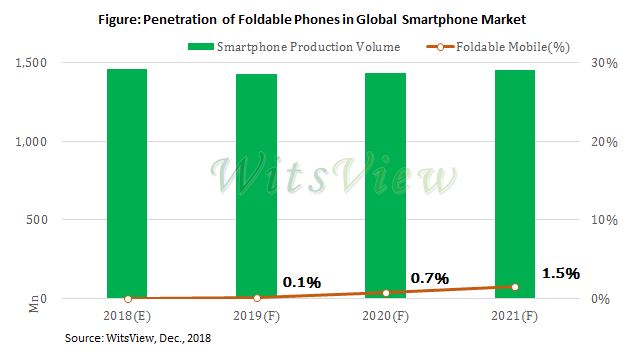Growth Expected to Return to Smartphones
TAIPEI — Smartphone unit volumes are likely to return to low single-digit percentage growth in 2018 after unit sales declined in the fourth quarter for the first time ever, according to market research firm IDC.
The overall market is predicted to reach a compound annual growth rate (CAGR) of 2.8 percent over period from 2017 to 2022, with shipments forecast to grow to reach 1.68 billion units, IDC said in a report. The report is in line with a similar report from market watcher Gartner.
"The fact that China alone declined almost 5 percent in 2017 was a huge factor for why global volumes fell, but Europe, Middle East and Asia also declined 3.5 percent, and the U.S. market was flat,” IDC Vice President Ryan Reith said in the report.
Developing markets still have plenty of room for growth, led by first-time buyers, according to IDC. While the segment for premium phones will continue to represent roughly 20 percent of the market, competition will continue to tighten and consolidation is inevitable, Reith said.
Apple took the lead from Samsung mainly on the strength of a wide range of handsets including its latest, iPhone X, according to IDC.
Technology advances are less about hardware aesthetics and more about components and software, according to the report. This shift makes differentiation a challenge, especially as the entire industry is sprinting towards bigger screens and smaller bezels, IDC said.
In 2018, phablets will outship smartphones, essentially ending the race for bigger screens, the report said. Big differences in quality and display type still exist, but the average consumer will struggle to understand these differences, according to IDC.
As 5G momentum builds, device OEMs, component suppliers, telcos, and services companies are all looking to capitalize on the new business opportunity, the report said. IDC expects commercial 5G smartphones to hit the market in 2019, ramping up to account for roughly 18 percent of worldwide shipments by 2022.
“To keep up with the increasing demand for new AI, AR/VR, contextually aware and 5G functionalities, we expect growth to come from improvements in overall core functions in the near term," said IDC Research Manager Anthony Scarsella.
Improvements in speed, power, battery life and general performance will be critical in driving growth at a worldwide level as the smartphone evolves into a true all-in-one tool, Scarsella said. Although these types of improvements continue each year, delivering them more affordably will be more significant to consumers as emerging markets remain crucial in driving growth throughout the forecast period, he said.
Android Phones Flat
Android volumes were flat in 2017, with OEMs shipping a total of 1.24 billion handsets running Google's OS, according to IDC.
After years of vendors customizing Android's OS with their own user interfaces, the market is shifting back to plain-vanilla Android handsets, the report said. This is an initiative that Google has been pushing for quite some time as standardization on software can bring faster updates, minimize consumer confusion and potentially allow Google to gain back some control of the platform, IDC said.
The biggest change for Android devices in 2017 was that average selling prices grew for the first time since 2010, according to the report. This is largely due to low-end players migrating their product lines toward mid-tier prices, the report said. Consumers have accepted this trend, although many low-end buyers have grown frustrated with poor battery and performance issues, according to IDC.
iOS Gains
Following the first annual decline in iPhone shipments in 2016, Apple returned to growth in 2017 with a slim 0.2 percent gain, the report said. Apple shipped 215.8 million iPhones in 2017 with 64 percent of the total coming from 'Plus'-size iPhones including the latest X model.
A shift to bigger, more expensive devices has allowed Apple to continue to grow its ASPs together with shipment volumes, according to IDC. IDC expects iPhone shipments to grow 3.7 percent to 223.8 million units in 2018 and reach 242.4 million units by 2022.
Overall iPhone volumes are expected to grow at a five-year CAGR of 2.4 percent, IDC said. Apple will continue to experience challenges breaking into some of the remaining high-growth developing markets, but there is no question they are far from being pushed out of the premium market segment, according to the report. Apple continues to expand its device upgrade program, a move IDC believes could be a catalyst to support growth over the next five years.
在线留言询价
- 一周热料
- 紧缺物料秒杀
| 型号 | 品牌 | 询价 |
|---|---|---|
| CDZVT2R20B | ROHM Semiconductor | |
| BD71847AMWV-E2 | ROHM Semiconductor | |
| RB751G-40T2R | ROHM Semiconductor | |
| MC33074DR2G | onsemi | |
| TL431ACLPR | Texas Instruments |
| 型号 | 品牌 | 抢购 |
|---|---|---|
| ESR03EZPJ151 | ROHM Semiconductor | |
| STM32F429IGT6 | STMicroelectronics | |
| TPS63050YFFR | Texas Instruments | |
| BP3621 | ROHM Semiconductor | |
| IPZ40N04S5L4R8ATMA1 | Infineon Technologies | |
| BU33JA2MNVX-CTL | ROHM Semiconductor |
- 周排行榜
- 月排行榜
AMEYA360公众号二维码
识别二维码,即可关注


























